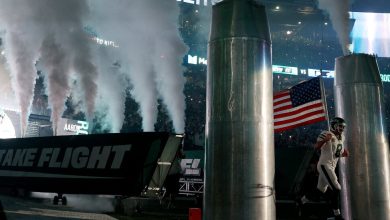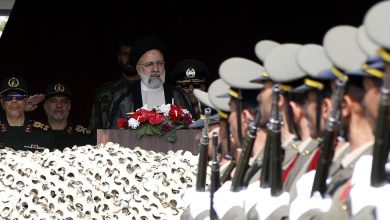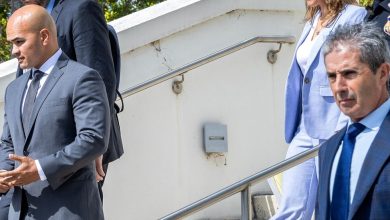As War Talk Cools in Ukraine, Jockeying for Diplomatic Advantage Begins

KYIV, Ukraine — The march to war in Ukraine slowed a bit on Wednesday, as Russia announced further troop withdrawals and, with Ukraine, signaled a willingness to explore diplomatic solutions to the crisis, including Ukraine’s forgoing its ambitions to join NATO.
After months of rejecting the Kremlin’s demands that NATO rule out Ukraine’s membership, American officials have begun to signal that the question is one for Ukrainians themselves to decide. Even President Volodymyr Zelensky of Ukraine has softened a bit recently, saying “it seems to me that no one is hiding it anymore.”
But the outlines of any diplomatic solution to the crisis remained indistinct. Further tempering optimism, Western leaders said they had seen no evidence either of Russia’s withdrawal of troops from the Ukraine theater that Moscow had announced a day earlier.
Secretary of State Antony J. Blinken, in an interview on MSNBC, said that the military units critical for an invasion force were continuing to move “toward the border, not away from the border.”
In Brussels, defense ministers from the NATO countries discussed ways to reinforce military positions on its eastern perimeter, while the group’s secretary general, Jens Stoltenberg, said he also saw nothing to support Russia’s claim of a drawdown. “What we see is that Russian troops are moving into position,” Mr. Stoltenberg said.
Much of the attention on Wednesday focused on potential diplomatic avenues to resolve the crisis. Mixed signals emanating virtually daily from Kyiv and Moscow have posed a challenge for diplomats, analysts and military planners. All sides are following delicate strategies, trying to appear resolute but not inflexible, so as to avoid blame in the event of war.
“There’s a lot of bluffing,” said Igor Novikov, a former foreign policy adviser to Mr. Zelensky. “It’s a poker game at the moment. But a very dangerous poker game.”
After talking up the prospects for diplomacy in recent days, Mr. Putin went silent on the crisis, taking no questions after meeting with President Jair Bolsonaro of Brazil, though his government continued to telegraph openness to diplomacy and dismissed the idea of an invasion.
The Russian Defense Ministry released a video of a military convoy departing Crimea over the 12-mile bridge to Russia that Mr. Putin ordered built after the peninsula’s 2014 annexation. The Kremlin’s spokesman, Dmitri S. Peskov, praised the United States for being willing to negotiate and offering constructive ideas.
“For us it is important that the rational seeds put forward by the Americans should be discussed together with topics that are of priority to us,” Mr. Peskov said. “We hope that these negotiations will start.”
For Mr. Putin, Russian analysts said, the plan remained to use the threat of war to achieve far-reaching objectives that he would prefer to attain peacefully: a rollback of NATO’s presence in Eastern Europe and the recognition of a Russian sphere of interest in the region, including Ukraine.
Dmitri Trenin, the director of the Carnegie Moscow Center, said he expected many Russian troops to remain positioned near the border, in part to maintain that state of tension. “He will keep the pressure on until he gets a satisfactory answer to his main question,” he said.
Mr. Putin appeared to dial down tensions this week in part because he had already made important early gains in a diplomatic effort that could still last for months. The United States, for instance, said it was prepared to revive talks on the placement of short and intermediate-range missiles in Europe. Some dialogue had already begun last year.
Mr. Putin has multiple ways to keep the pressure on, among them ominous new military moves, disinformation and cyberattacks. He can also wield political tactics like Tuesday’s vote in Russia’s Kremlin-controlled Parliament that called on Mr. Putin to recognize the independence of the Russian-backed separatists in eastern Ukraine, a move that he said he was not yet prepared to make.
“We are at the end of the beginning,” Mr. Trenin said, suggesting negotiations could continue for some time. “The game itself is still to come.”
One aspect has already emerged into public view: a discussion underway by European, Russian and Ukrainian leaders and officials over whether Ukraine might resolve the threat by abandoning its ambitions to join NATO. Analysts say the trick will be to devise a plan that will be acceptable to the Kremlin without provoking a backlash in Ukraine that could destabilize the government.
Understand the Escalating Tensions Over Ukraine
A brewing conflict. Antagonism between Ukraine and Russia has been simmering since 2014, when the Russian military crossed into Ukrainian territory, annexing Crimea and whipping up a rebellion in the east. A tenuous cease-fire was reached in 2015, but peace has been elusive.
A spike in hostilities. Russia has been gradually building up forces near its border with Ukraine, and the Kremlin’s messaging toward its neighbor has hardened. Concern grew in late October, when Ukraine used an armed drone to attack a howitzer operated by Russian-backed separatists.
Preventing an invasion. Russia called the strike a destabilizing act that violated the cease-fire agreement, raising fears of a new intervention in Ukraine. Since then, the United States, NATO and Russia have been engaged in a whirlwind of diplomacy aimed at averting that outcome.
The Kremlin’s position. President Vladimir V. Putin of Russia, who has increasingly portrayed NATO’s eastward expansion as an existential threat to his country, said that Moscow’s growing military presence on the Ukrainian border was a response to Ukraine’s deepening partnership with the alliance.
Rising tension. Western countries have tried to maintain a dialogue with Moscow. But the Biden administration warned that the U.S. could throw its weight behind Ukraine in case of an invasion. France, Germany and Poland also warned Russia of consequences if it launched incursions into Ukraine.
“Everyone must step back a bit here and make it clear to themselves that we just can’t have a possible military conflict over a question that is not on the agenda,” Germany’s chancellor, Olaf Scholz, said after meeting with Mr. Putin on Tuesday, speaking of Ukrainian NATO membership.
A Ukrainian deputy prime minister, Iryna Vereshchuk, suggested a referendum as a way to sell what would surely appear to be a concession to the Ukrainian public.
“The president assumes there is such a possibility, if there are no other options or tools,” Ms. Vereshchuk said in an interview on Ukrainian television. The prospects of Russia agreeing to a referendum are uncertain, as preparations could take months, during which it would be costly for Moscow to continue to maintain the threat of an imminent invasion.
But in a signal of possible American support, Wendy R. Sherman, the deputy secretary of state who in earlier rounds of talks had refused to accede to Russian demands that the United States rule out NATO membership for Ukraine, said in an interview published Wednesday that it would support any decision made by the Ukrainians.
“This decision remains with the Ukrainian people, what they want, where they see their future,” Ms. Sherman told Yevropaiska Pravda, a Ukrainian news outlet. “This is your choice.”
It seems certain that Mr. Putin will not be satisfied with simple assurances that Ukraine has no intention of joining NATO currently, or a vague moratorium. “They are telling us it won’t happen tomorrow,” he said Tuesday. “Well, when will it happen? The day after tomorrow?”
Analysts have suggested setting a length for a moratorium, say 20 to 25 years, to assuage Mr. Putin’s misgivings.
Mr. Scholz pressed the idea of a lengthy delay, saying any Ukrainian entry into NATO was not likely during either of their terms in office. “I don’t know how long the president intends to stay in office,” he said, in a rare barb by a German leader directed at Mr. Putin. “I have a feeling for a little while yet, but certainly not forever.”
Senior Russian officials had some fun of their own, needling Washington for its prediction that an invasion could start on Wednesday — perhaps in the wee hours of the morning, according to some news reports. Maria V. Zakharova, the Foreign Ministry’s often caustic spokeswoman, said she would appreciate U.S. and British news outlets publishing the schedules for Russia’s “invasions” in the coming year, because “I’d like to plan my vacation.”
Andrew E. Kramer reported from Kyiv, and Anton Troianovski from Moscow.




